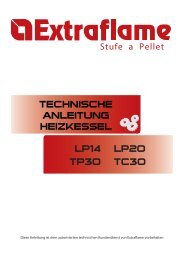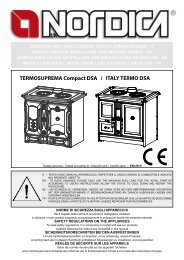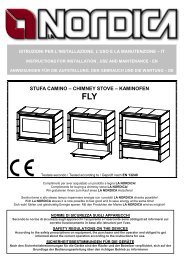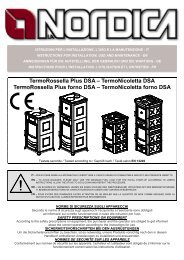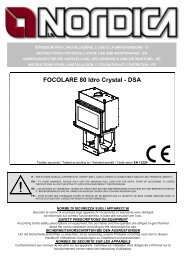TERMOSOVRANA - DSA - HJS-Internethandel
TERMOSOVRANA - DSA - HJS-Internethandel
TERMOSOVRANA - DSA - HJS-Internethandel
Create successful ePaper yourself
Turn your PDF publications into a flip-book with our unique Google optimized e-Paper software.
TermoSovrana <strong>DSA</strong><br />
near the appliance or by placing piping for combustion air which leads outside or to a nearby airy place, with the<br />
exception of the boiler room or garage (FORBIDDEN).<br />
The connection pipe must be smooth with a minimum diameter of 120 mm. It must have a minimum length of 4 m and<br />
have no more than three bends. If it is directly connected to the outside, it must be equipped with a suitable<br />
windbreak.<br />
The intake of air for combustion in the place of installation must not be obstructed during operation by the<br />
thermocooker. It is absolutely essential that in environments in which thermocookers are operated with a natural<br />
chimney draught, as much air as is necessary for combustion is introduced, i.e. up to 25 m³/hour. The natural<br />
recirculation of air must be guaranteed by some fixed openings to the outside. Their size is established by regulations<br />
regarding the subject. Ask for information from a chimneysweep. The openings must be protected with grills and must<br />
never be blocked up. An extractor hood (suction) installed in the same room or in a neighbouring one causes a<br />
depression in the environment. This causes the leakage of burnt gas (dense smoke, smell); it is therefore necessary<br />
to ensure a greater flow of fresh air.<br />
The depression of an extractor hood can, in the worst case scenario, transform the flue of the thermocooker<br />
into an external air inlet, resucking the flue gases into the environment with very serious consequences for<br />
persons.<br />
8. PERMITTED/FORBIDDEN FUELS<br />
The permitted fuels are wooden logs. Only dry wooden logs must be used (water content max 20%). The pieces of<br />
wood should have a length of about 30 cm and circumference of 15 - 18 cm max.<br />
The wood used as fuel must have a humidity content lower than 20% which is obtained with a drying time of at least<br />
one year (soft wood) or two years (hard wood) placing it in a dry, airy place (for example under roofing). Damp wood<br />
makes lighting more difficult, as a greater quantity of energy is necessary to make the water present evaporate. The<br />
humidity content also has the disadvantage, as the temperature goes down, of causing the water to condense first in<br />
the furnace and then in the chimney. Fresh wood contains about 60% H 2 O, therefore it is not suitable for burning.<br />
Among other things which cannot be burned: carbon residues, cuttings, bark waste and panels, wood which<br />
is damp or treated with varnishes, plastic materials; in this case, the appliance warranty is forfeited.<br />
Paper and cardboard must only be used for lighting. The combustion of rubbish is forbidden and would also<br />
damage the thermocooker and the flue, causing damage to health and, due to the bad smell, causing complaints from<br />
the neighbouring area.<br />
Wood is not a long-lasting fuel and therefore it is not possible to use the thermocooker for continuous heating during<br />
the night.<br />
CAUTION: The continuous and prolonged used of wood which is particularly rich in aromatic oils (e.g.<br />
Eucalyptus, Myrtle etc.) causes the sudden deterioration (flaking) of the cast iron components present in<br />
the product.<br />
Type Kg/m3 KWh/kg 20% humidity<br />
Beech 750 40<br />
Turkey oak 900 4.2<br />
Elm 640 4.1<br />
Poplar 470 4.1<br />
Larch* 660 4.4<br />
Norway spruce* 450 4.5<br />
Scotch pine* 550 4.4<br />
* RESINOUS WOOD UNSUITABLE FOR THE THERMOCOOKER<br />
9. IGNITION<br />
WARNING: For no reason turn on the fire before the system has been completely filled with water; doing so<br />
could cause serious damage to the entire structure.<br />
IMPORTANT: during the first ignition, it is inevitable that an unpleasant smell is produced (due to the drying of the<br />
adhesives in the sealing cord or the protective varnishes), which disappears after a short use. The<br />
environment must nevertheless be well ventilated. On first ignition, we recommend loading a reduced<br />
quantity of fuel and increasing the calorific power of the appliance.<br />
To carry out a correct first ignition of the products treated with varnishes for high temperatures, it is necessary to know<br />
the following information:<br />
28 7094211 Rev.03 – EN



